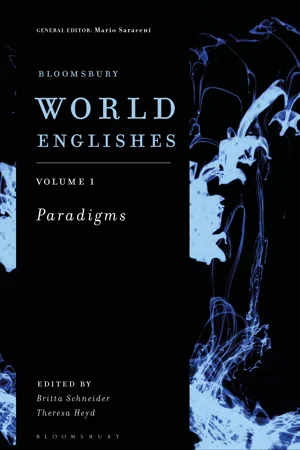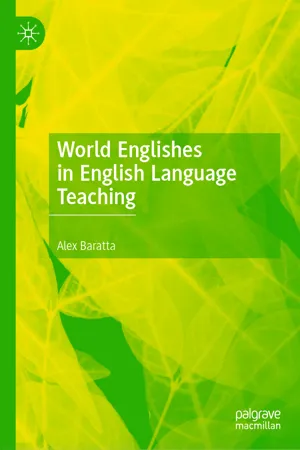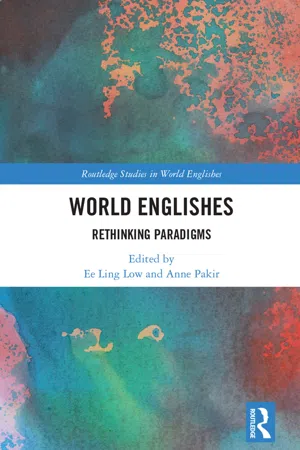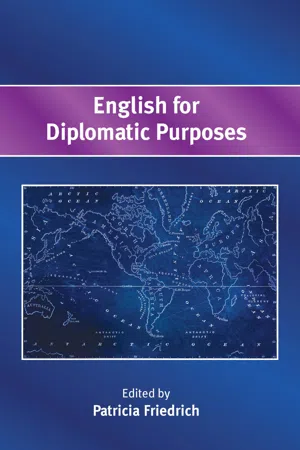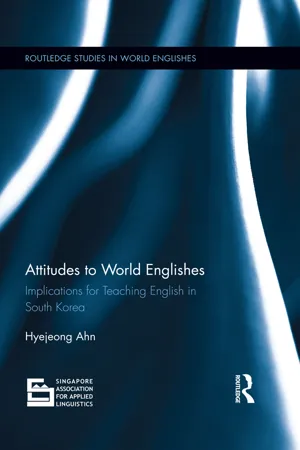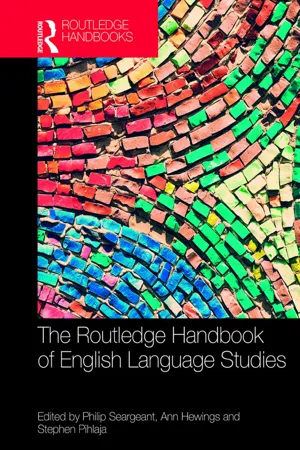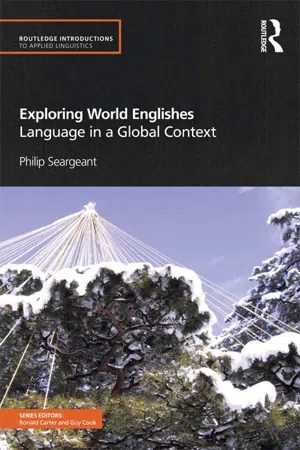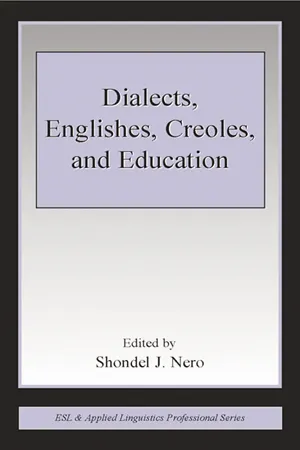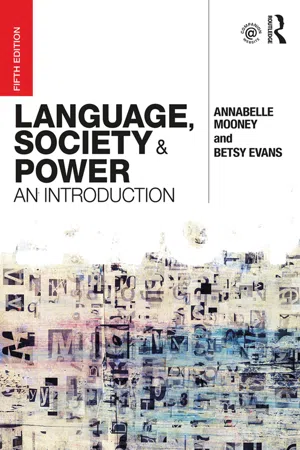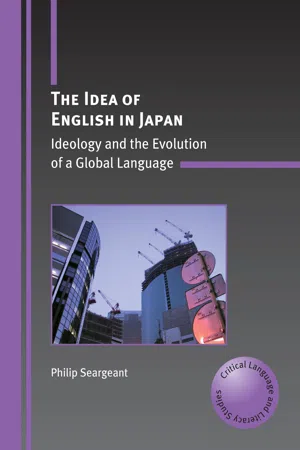Languages & Linguistics
World Englishes
World Englishes refers to the various forms and varieties of the English language used around the world. It acknowledges the diverse ways in which English is spoken, written, and used in different cultural and linguistic contexts. This concept highlights the dynamic and evolving nature of English as a global language, influenced by local cultures and languages.
Written by Perlego with AI-assistance
Related key terms
10 Key excerpts on "World Englishes"
- eBook - ePub
- Britta Schneider, Theresa Heyd, Mario Saraceni(Authors)
- 2021(Publication Date)
- Bloomsbury Academic(Publisher)
The discussion of future scenarios for the spread of English and English language teaching worldwide. 1997–presentEnglish as an international language (EIL)The broad study of English as an international and/or auxiliary language. A term variously used to refer to the uses of English(es) in diverse contexts across/between/in the Three Circles worldwide. 1976–presentEnglish as a lingua franca (ELF)An approach to English focusing on those contexts, for example universities and international businesses, where English is used as a common language by speakers of different nationalities and linguistic backgrounds.Late 1990s–presentCultural linguisticsResearch on cross-cultural communication and cultural schemas in the context of World Englishes. 2000s–present Adapted from: Bolton 2020Over the last four decades, the World Englishes approach to English worldwide has succeeded in creating a major paradigm shift in academic English studies internationally. The study of World Englishes is now recognized as a branch of linguistics at many universities worldwide, and to a large extent has now established itself as a discipline in its own right, with its own educational programmes and discourse community. In this context, it can now be argued thatthere is now a stable body of knowledge that constitutes a subject entitled World E nglishes studies, and . . . that there has been a paradigm shift in the way that the academic mainstream now focuses on the teaching and research of diverse varieties of English [which] affects not only sociolinguistic studies of English around the world, but also applied linguistics scholarship, and in this way feeds into the training of language professionals, specifically TESOL practitioners and those involved in language planning. (Seargeant 2012 - eBook - ePub
- Alex Baratta(Author)
- 2019(Publication Date)
- Palgrave Macmillan(Publisher)
standard English . Further, difference is a purely objective manner in which to refer to linguistic variety in the sense that it is purely factual that varieties of English, by definition, exhibit differences from each other and difference does not mean, or imply, deficit, which none of the participants thus far has implied.If we expand on some of these twenty nine responses, more so those which provided more detailed answers, then there is much we can glean from participants’ understanding of, and attitudes toward, World Englishes . For example, P14 referred to World Englishes as ‘a localised variety that has developed in a specific region, often due to historical contact with the English language’. This might appear to apply to outer circle Englishes specifically, but if we hone in on ‘localised variety’, then this is implying that given a localised version of something, in this case a language, we can perhaps only expect change to take place. We can expect, as these twenty nine participants have alluded to, linguistic difference. The question is then raised, however, as to what World Englishes are different from, exactly. Is there a definitive version, which itself is different from other versions, but by being the definitive version, it is implied that this is the standard to ultimately achieve? Of all thirty six participants, only two specifically mentioned difference in regard to inner circle English . P4 referred to World Englishes as ‘modified versions of English spoken within a group or nationality of English speakers (who otherwise may not speak English as their native language) which sees rules of grammar changed and lexis carrying different meanings to, for example, British English ’. P11 gave a more brief explanation, that World Englishes are ‘different Englishes which are used around the world which differ from British /American English - eBook - ePub
World Englishes
Rethinking Paradigms
- Ee Ling Low, Anne Pakir(Authors)
- 2017(Publication Date)
- Routledge(Publisher)
5Teaching English as an international languageA WE-informed paradigm for English language teaching
Aya Matsuda and Paul Kei Matsuda5.1 Introduction
One word that describes the sociolinguistic landscape of the English language today is “messy.” The geographical spread of English has resulted in the emergence of new varieties of English – or Englishes – that reflect and serve the communicative needs of local users more effectively than dominant forms of English. The spread also has resulted in broader and more complicated definitions of the English speaker and the English-speaking culture. English speakers today are quite heterogeneous and diverse; they come from diverse linguistic, cultural and educational backgrounds. They have learned English in different ways and for different purposes from traditional English users. The cultural assumptions and frames of reference they bring to the table are equally diverse and often unpredictable. Their own variety of English may be the only language they know or it may be part of their larger linguistic repertoire. They may live in English-dominant contexts or contexts where English co-exists with other languages. Or they may transcend various communities where English may be used differently and to varying degrees.World Englishes (WE) has been one of the earliest and most influential intellectual traditions to systematically investigate the messiness of the English language, exploring the diversity of Englishes in terms of the structure as well as its users and uses. Over the years, WE studies have amassed a substantial body of knowledge in various aspects of the spread and diversification of Englishes. Some of the key insights related to the globalization of the English language include: descriptions of the nativization process of various Englishes (e.g., Kachru, Kachru, & Nelson, 2006; Kirkpatrick, 2010); the interaction among different languages in the process of language use, such as hybridity and code-switching (e.g., McLellan, 2010; Schneider, 2016); the problematic dichotomy between native and non-native users of English1 ; (e.g., Matsuda, forthcoming b; Selvi, 2014); and the language policies and their impact on language users (e.g., Bamgbos˙e, 2006; Kamwangamalu, 2016), among others. Another important area of research within the WE tradition is the pedagogical implications of the messiness of the English language today (Matsuda, 2012a, 2012c), which has had a significant impact on the development of Teaching English as an International Language - eBook - ePub
- Patricia Friedrich(Author)
- 2016(Publication Date)
- Multilingual Matters(Publisher)
5 World Englishes and Peace Linguistics: Their Contribution to English for Diplomatic PurposesPatricia Friedrich IntroductionWorld Englishes is an academic orientation and a way of seeing linguistic relationships that acknowledges the existence of great variation across linguistic expressions in the English language. These variations are historically and culturally motivated and are also, as a matter of course, to be expected in a language that has grown to be used by a very large portion of the world’s population for a very large number of functions.To acknowledge the reality, contribution, and role of World Englishes is to in a way endorse a view of the world according to which difference is treated as inclusive diversity and where one’s position in the world of languages is also seen in relative rather than absolute terms. That is, World Englishes scholars and students are more interested in describing and analyzing Englishes as they happen in the world and as they are manifested within different cultures than in prescribing extrinsic rules. Once aspects of the dynamics of English use and need are known, one can use the information to create better pedagogical practices, language policies, etc.In this chapter, I will first present some basic tenets of World Englishes to then bring it together with Peace Linguistics to highlight the importance of the acknowledgment of Englishes in diplomatic communications. I will also briefly document how Peace Linguistics elements, aligned to World Englishes perspectives, further enhance the job of those working toward an equally peace-fostering diplomacy. The chapter will close with activities that teachers of Diplomatic Englishes can present in the classroom or that learners of Diplomatic English can attempt on their own. The ultimate goal is that, when engaged in diplomatic negotiations, users of Diplomatic Englishes remember that language also needs to be negotiated, that the form of our words matters, and that one’s view and use of English is relative to their place in the world, linguistic background and linguistic repertoire. Accessing these aspects of linguistic communications can help those engaged in acts of diplomacy get the best of their interactions, as they pursue greater peace and understanding and their best interests along with the interests of their counterparts. - eBook - ePub
Attitudes to World Englishes
Implications for teaching English in South Korea
- Hyejeong Ahn(Author)
- 2017(Publication Date)
- Routledge(Publisher)
World EnglishesChanges in language occur over time, resulting in modifications of phonological, lexical, syntactic, semantic, pragmatic and other diachronic shifts. At any given moment a language, and English is no exception, also has variation within itself amongst different communities of its speakers, and this variety is known as synchronic variation (Saussure, 1966). Kachru (1988) argues that there are two kinds of language contact situations involving English. The first is where there are changes to the local language due to the influence of English, which is termed ‘Englishisation’. The second is the nativisation of English, which occurs when the English language undergoes linguistic assimilation with features of the local language. He introduces the field of World Englishes and provides arguably one of the most critical and influential models describing the diversified spread of the English language globally. The first edition of The Other Tongue by Kachru (1982) outlines aspects of variations in English languages and their demographic spread. Since the publication of the book, studies of World Englishes have been undertaken extensively, discovering that the English language has been proven to be one of the most hybrid and rapidly changing languages in the world (Bolton, 2003; Graddol, 2000, 2006; Jenkins, 2009b, 2015; Kirkpatrick, 2007b, 2010b; Kirkpatrick & Sussex, 2012; Mufwene, 1996; Schneider, 2003, 2014b; Xu, 2010b).1.1 Three Concentric Circles
The pioneer scholar of World Englishes, Kachru (1982), challenges the traditional view of English as a language of a particular country. Instead he advocates a pluri-centric conception of English and so developed the controversial ‘Concentric Circles’ model, marking pluralisation of English to describe the social reality of diversified users and varieties of English. His model comprises three circles: Inner Circle, Outer Circle and Expanding Circles (Kachru, 1992b). The three circles ‘represent the types of spread, the patterns of acquisition, and the functional allocation of English in a diverse cultural context’ (Kachru, 1992b, p. 356). The Inner Circle consists of countries such as the United Kingdom (UK), the United States of America (USA) and Australia, where English is used as the primary language and the mother tongue. A major characteristic of the varieties spoken in these countries is largely that they are ‘endonormative’ (Banjo, 1993, p. 261) in that they find within themselves the norms of correctness and appropriateness to be propagated through their own language. In the Outer Circle countries, English has been institutionalised as an additional language. This circle includes countries such as India, Singapore and the Philippines. Typically, these countries came under British or American colonial administration before acceding to independence. English in these countries continues to be used for intra-ethnic communication in various social, educational and administrative domains. Finally, the Expanding Circle includes the rest of the world, including France, South Korea, Russia and Brazil, where English is mainly used as a foreign language. Generally, English in the Expanding Circle is not widely spoken for communicative purposes but extensively taught within the education system. Educators and policy makers in the Expanding Circle countries have traditionally preferred AmE or BrE as target models of English education (Bruthiaux, 2003; Kirkpatrick, 2007a; Matsuda, 2003a, 2003b; McKay, 2002). - Philip Seargeant, Ann Hewings, Stephen Pihlaja(Authors)
- 2018(Publication Date)
- Routledge(Publisher)
From the 1980s to the present the WE project has contributed to a major theoretical shift in English studies worldwide, in large part through the pioneering foundational work of Braj B. Kachru, which from the outset argued for a paradigm shift of two types: (i) ‘a paradigm shift in research, teaching, and the application of sociolinguistic realities to the functions of English’, and (ii) ‘a shift from frameworks and theories which are essentially appropriate only to monolingual countries’, involving a pluralism which is ‘reflected in the approaches, both theoretical and applied, we adopt for understanding this unprecedented linguistic phenomenon’ (Kachru 1997, in Webster 2015: 175, Vol. 2). At this point in its development, the WE enterprise may be regarded as having reached a point of maturity or even orthodoxy within English studies and linguistics, but this remains a diverse and pluralistic field, and, as its ethos suggests, WE remains open for new directions, new insights, and new energies.Notes1 Interest in the diverse forms and functions of so-called ‘new Englishes’ throughout the world has been paralleled by a related interest in new literatures in English, particularly from writers originally from former British colonies, such as V. S. Naipaul, Michael Ondaatje, Timothy Mo, Ben Okri, Wole Soyinka, Arundhati Roy, Salman Rushdie, and Derek Walcott (King 2005).2 To some extent, studies using an English as a Lingua Franca (ELF) approach may be seen as a contemporary updating of an earlier approach to research, which highlighted the role of English as an International Language (EIL). This approach was associated with linguists such as Smith (1976, 1981), Strevens (1980), McKay (2002) and Sharifian (2009). Theorists of ELF have stated that early EIL researchers may be seen as ‘precursors’ in the field of English as a Lingua Franca (Ehrenreich and Pitzl 2015).Further readingBolton, K. and B. B. Kachru (eds) (2006) World Englishes: Critical Concepts in Linguistics. Vol. 6. Abingdon: Routledge. This provides a definitive collection of articles on WE from a range of perspectives, including theoretical approaches, regional profiles, paradigms of description, codification, intelligibility, language contact, discourse studies, corpus linguistics, the politics of language, and globalization.Melchers, G. and P. Shaw (2009) World Englishes: An Introduction. 2nd edn. London: Arnold. A carefully-researched and well-designed textbook on English worldwide, which provides a detailed description of the linguistic features of varieties in many regions of the world.Seargeant, P. (2012) Exploring World Englishes: Language in a Global Context- eBook - ePub
Exploring World Englishes
Language in a Global Context
- Philip Seargeant(Author)
- 2012(Publication Date)
- Routledge(Publisher)
Pride, 1982; Platt et al., 1984), though it has been mostly superseded by World Englishes now. The focus of both terms was initially predominantly on the second-language varieties which developed in former British colonies. As Kachru has pointed out, New Englishes was always a rather misleading term though, as the English spoken in India, for example, is actually older than that spoken in Australia, but the former is included in the category of New Englishes whereas the latter is not (Kachru, 1983). Another term with a similar scope is ‘Postcolonial Englishes’, which Edgar Schneider uses to cover all those varieties which have their roots in colonial activities, including American and Australian English, as well as English-related Creoles (Schneider, 2007). 6 English as multiplex There is a certain amount of overlap between this category and the preceding one in the way in which they both stress the plurality of varieties. The extremely broad scope of reference for the terms in category 6 means, however, that they are not used to conceptually divide the field for analytic purposes, but merely to highlight the diversity of the field, and to provide a name which does not imply a monolithic English. World English As used by Tom McArthur, World English is meant to imply the diverse nature of the language: “For me, world English is both shorthand for English as a world language and a superordinate term for Australian English, British English, Irish English, Nigerian English, and the like. It embraces all aspects of the language: dialect, pidgin, Creole, variety, standard, speech, writing, paper-based, electronic” (McArthur, 2004, p. 5). Used at an early stage in the academic consciousness of the field, the term served a very wide remit, drawing attention to the spread and diversity of the language - eBook - ePub
- Shondel J. Nero(Author)
- 2012(Publication Date)
- Routledge(Publisher)
Language and culture in multilingual societies: Viewpoints and visions (Anthology Series 36). Singapore: SEAMEO Regional Language Center.Vavrus, F. (1991). When paradigms clash: The role of institutionalized varieties in language teacher education. World Englishes, 10(2), 181–195.Widdowson, H. G. (1994). The ownership of English. TESOL Quarterly, 28, 377–392.Zhang, H. (2003). Chinese Englishes: History, contexts, and texts. Unpublished doctoral dissertation. Urbana: University of Illinois.1 Englishes spoken in the Caribbean, Melanesia, Polynesia, South America as well as the so-called non-standard varieties spoken in North America, the UK and other parts of the world are also part of World Englishes. The issues relevant to these varieties have been addressed elsewhere in this volume.2 Ghana, India, Kenya, Nigeria, Pakistan, the Philippines, Singapore, Sri Lanka, and others in this category are characterized as members of the Outer Circle whereas Brazil, China, Egypt, France, Germany, Italy, Japan, Korea, Malaysia, Saudi Arabia, Thailand, Turkey, Russia, Venezuela, and others that were British or American colonies are members of the Expanding Circle.3 This is what happened when American forces occupied the Philippines in late nineteenth century and Japan following World War II. Following the Korean War, English education was revived in Korea under the American influence. In the colonies of Africa and Asia, English education was imposed by the British empire and was later adopted and adapted by the independent nations of the regions as a result of their own internal needs and aspirations. For a detailed discussion of these historical facts, see Baik (1995), Bamgbose (1971), Gonzalez (1997), Ike (1995), B. Kachru (1983), Rahman (1990), among others.4 - eBook - ePub
Language, Society and Power
An Introduction
- Annabelle Mooney, Betsy Evans(Authors)
- 2018(Publication Date)
- Routledge(Publisher)
The power and prevalence of attitudes about different varieties of English are captured by Jenkins’s inclusion of governments, prescriptivists and the general public. And while Jenkins’s position is very attractive, as it acknowledges that all these varieties of English do count as ‘English’, it is nevertheless important to pay some attention to the attitudes to English that are so prevalent.If all varieties of English are included in a visual model of World Englishes, the possible ‘circles’ can be redrawn.Figure 10.2 McArthur’s Circle of World English (1987)Source : McArthur, Tom (1987) ‘The English Languages?’ in English Today 11: 9–11Figure 10.2 seems to support Jenkins’s interpretation of ‘World Englishes’ by including all varieties. Significantly, what this representation calls into question is the possibility of talking about ‘English’ as unspecified. At best, ‘English’ is a convenient abstraction which hides a great deal of variation in terms of phonology, syntax and lexis and also in terms of domains of use and power.What these two different representations suggest is that we can approach World Englishes from a number of perspectives. The perspective chosen depends very much on the argument one wants to make.The idea that there is a global English that is the same all over the world is unfounded. If it could be developed, it is unlikely that it would remain unchanged. As Mufwene remarks, ‘If WSSE [World Standard Spoken English] were to arise spontaneously, or could do so at all, it would be the first such evolution toward linguistic uniformity in the history of language spread and contact’ (2010: 46). In a sense, there is no such language as English – at least, it exists only in the most abstract of conceptions. And if we focus on speakers of English, it is also extremely difficult to place individuals in any of these models (see Galloway and Rose, 2015: 23).10.3 Learning EnglishLearning English or any language as a second or additional language will usually mean that speakers will be found wanting when compared to the L1 standard. As we discuss here, linguists have argued that to use inner circle English norms as the ‘standard’ that all speakers should aim for is to create a goal that is both impossible and stigmatising. - eBook - ePub
The Idea of English in Japan
Ideology and the Evolution of a Global Language
- Philip Seargeant(Author)
- 2009(Publication Date)
- Multilingual Matters(Publisher)
Chapter 3Language Ideology and Global EnglishPolitics and the Emergence of the World Englishes Paradigm
It is since the outset of the 1990s that politics has become an overt concern for research into world English. Prior to this, it was more specifically linguistic concerns that initially dominated the discipline. These concerns were then recalibrated with the injection of sociolinguistic sensibilities into the research agenda, until the ‘critical turn’ in applied linguistics arrived to foreground the ubiquity of the political. At present, the discipline appears to be seeking a balance between these two poles, attempting to retain a linguistic focus on the affordances and constraints of the language faculty, while also plotting the effects within the social environment of language and language-related social practices. And it is here that a ‘language ideologies’ approach can offer great potential, as it takes as its site of inquiry the mediating forces between language form and language function, and places linguistic behavior firmly within an animating cultural context. This chapter will therefore examine theoretical precepts from this approach that might productively be applied to the global English question, and it will consider specifically how these can offer support in the development of a methodology for the analysis of the conceptualization of the English language in Japan. Firstly, though, I will briefly recite the stages of emergence of the World Englishes paradigm, and consider how the concept of ideology has hitherto featured within the genealogy of the discipline.In his review of the development and diversification of approaches to the study of English within globalized contexts, Bolton (2005) traces a narrative which begins in the 1960s with Randolph Quirk (e.g. 1968) and University College London's Survey of English Usage. This had as its brief the description of diverse varieties of the language, specifically in terms of syntactic structure and historical change. It took a predominantly linguistic approach, with the object of study being linguistic form rather than sociolinguistic function, and the concept of variety being formulated as (syntactic) divergence from a central standard. Ideological evaluation of language practices was thus encoded within the methodology (in the hierarchical ordering of central standard versus peripheral variety), but there was no explicit engagement with the political nature of either language practice or linguistic research.
Index pages curate the most relevant extracts from our library of academic textbooks. They’ve been created using an in-house natural language model (NLM), each adding context and meaning to key research topics.
